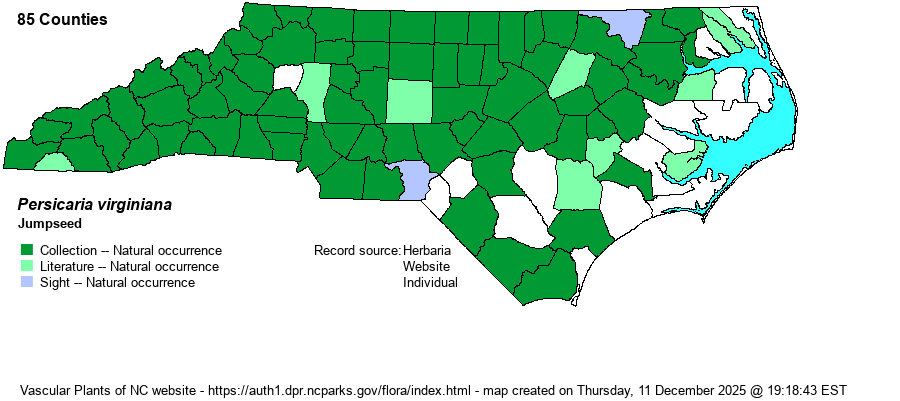| Author | (L.) Gaertner | |
| Distribution | Throughout most of the state, but absent from most of the outer Coastal Plain and the Sandhills proper.
NH and Que. to MN and NE, south to northern FL and TX; disjunct to central Mex. | |
| Abundance | Common in the Mountains and the northern half of the Piedmont. Fairly common to frequent in the southern Piedmont and northwestern Coastal Plain. Absent from the Sandhills proper, scarce in the southern Coastal Plain. | |
| Habitat | Moist or rich hardwood forests -- floodplain forests, oxbow ponds and backup channels, rich woods such as cove forests. Shows a preference for the increased nutrient levels of brownwater systems, especially in the Coastal Plain. |
| Phenology | Flowering and fruiting late June-October. | |
| Identification | Jumpseed has unique morphology: the stem is 1.5-2.5 feet tall, a few to several ovate, stalked, stem leaves 4-6 inches long, and long, rather arching, inflorescence branches with whitish, triangular in cross-section, hard fruits. The latter are attached under tension and when bumped they jump up to 9 feet. This is a quite familiar moist or rich forest species, with broad leaves and a distinctive, very slender and long (often 6-12 inches long) flower cluster with scattered white flowers and fruit. Not surprisingly, it has often been pulled apart into a separate genus -- formerly in Tovara. | |
| Taxonomic Comments | This unusual species has over the decades been treated in different genera, including Tovara and Antenoron.
Many species formerly treated in the genus Polygonum have been moved to Persicaria, the smartweeds. These are generally erect and tall plants with terminal and axillary floral spikes; most occur in wetlands. Others remain in Polygonum, the knotweeds, which are generally prostrate to ascending and with inconspicuous axillary flowers. They occur mostly in dry soils and tend to be weedy.
Attention must be paid to the small collars at the junction of the main stem and leaf stems (called ocreae) and whether they possess terminal hairs or bristles. Some keys also refer to the even smaller collars from which flowers emerge (called ocreolae). Another important ID character is the surface of the greenish sepals -- whether smooth or dotted with indentations (punctate). | |
| Other Common Name(s) | Virginia Knotweed, Woodland Knotweed | |
| State Rank | S5 | |
| Global Rank | G5 | |
| State Status | | |
| US Status | | |
| USACE-agcp | FAC link |
| USACE-emp | FAC link |

